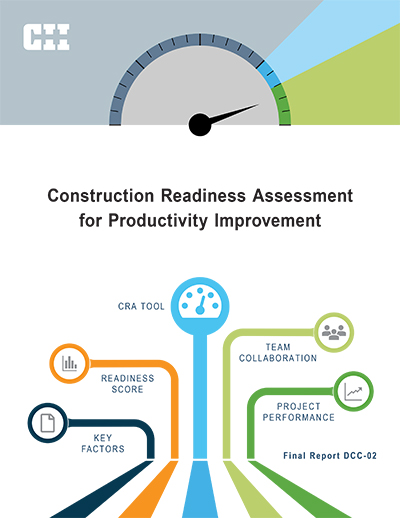
Construction Readiness Assessment for Productivity Improvement
Due to the competitive construction market and the omnipresent pressures of time and money on large-scale projects, project teams often launch into construction without taking time to adequately assess their construction readiness. As such, numerous projects begin construction before they are ready to do so, leading to poor productivity across project activities and unsatisfactory project performance. In addition, some other teams may delay too long past the point of construction readiness, incurring other problems, due to a lack of clarity in definition of construction readiness in today’s construction market.
In an effort to tackle this industry-wide problem, the Downstream and Chemicals Sector Committee selected “Construction Readiness Assessment for Productivity Improvement” to be one of its first funded research teams. The goal of this research is to quantitatively determine what qualifies a project as “construction-ready” while assisting project teams to improve and sustain the readiness level of their projects.
In pursuit of these research goals, RT-DCC-02 (hereafter referred to as “the research team”), derived 228 readiness factors from members’ industry expertise, the extant body of literature concerning construction readiness, and the current state of the practice in terms of construction readiness. These factors were further divided into 15 categories, including Project Team, Engineering, Planning, and Stakeholder Management. Once the factors were identified, a comprehensive survey was developed which collected data from 80 projects. These projects were divided into two sets:
- 41 projects that were Construction-Ready (CR)
- 39 projects were Construction-Not-Ready (CNR).
The next step was to determine the relative importance of the factors. Using the collected data, the team developed mathematical and statistical models to weight each factor, facilitating their comparison and the determination of importance.
The following factors had the highest weights in differentiating CR from CNR projects:
- Engineering factors – factors related to the development process of Issued-For-Construction (IFC) drawings
- Project Team factors – factors related to forming a multidisciplinary skilled team
- Planning factors – factors related to accounting for projects’ hold points and handoffs.
From these weights, the Construction Readiness Score (CRS) is computed. This single, unified metric allows the easy comparison of a project to itself over time (i.e., is this project becoming more ready through the actions of the project team) or to other projects executed by a company (i.e., is this project more or less ready than previously performed projects). The score is calculated by the Construction Readiness Assessment Tool (CRA), which not only calculates the CRS but also compares it to data-defined benchmarks for readiness as well as user-defined project goals. The CRA also identifies leverage areas that a project team may use to improve their readiness or maintain it over a project’s duration.
RT-DCC-02 derived 228 construction readiness factors spanning 15 categories. Using data collected from 80 projects, the readiness factors were weighted. A higher weight indicates a higher contribution in differentiating CR from CNR projects (RT-DCC-02, page 11).
Using the developed weights, the team created the Construction Readiness Score (CRS), which is a single unified metric that can be used to assess the readiness level of a project as a percentage. The CRS was then benchmarked to be used to classify future projects in one of three categories (RT-DCC-02, page 53):
- Construction-Not-Ready (CRS between 0% and 75%)
- Borderline (CRS between 75% and 85%)
- Construction-Ready (CRS between 85% and 100%)
RT-DCC-02 developed the Construction Readiness Assessment (CRA) tool, which is part of Final Report DCC-02. The CRA tool was built in Microsoft Excel and Visual Basic for Applications. The tool uses the weights of the 228 factors to compute a unified project readiness score, and subsequently compares that score to both the benchmarks identified in this research and user-defined project goals. The CRA tool further identifies leverage areas in which improvement can be made to increase or maintain construction readiness. Repeated use of the tool during the planning and construction phases of a project permits projects to be tracked as they progress toward construction readiness and to ensure that readiness is maintained after startup (RT-DCC-02, page 45).
NOTE: This publication’s accompanying beta software is a proof of concept and is available for informational purposes only. By downloading or purchasing this publication, you understand and accept that its accompanying software may stop opening or running properly on future platforms and is not supported or maintained by CII. Both the publication and its software are protected by applicable copyright restrictions as set forth by CII. Any party interested in adapting this software is invited to contact CII Associate Director for Deployment to discuss licensing.


